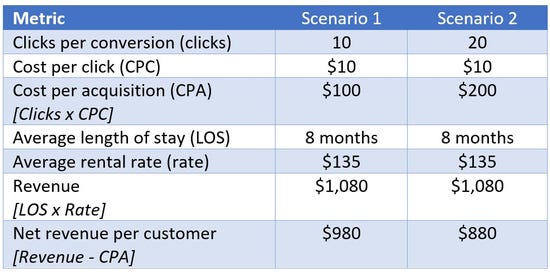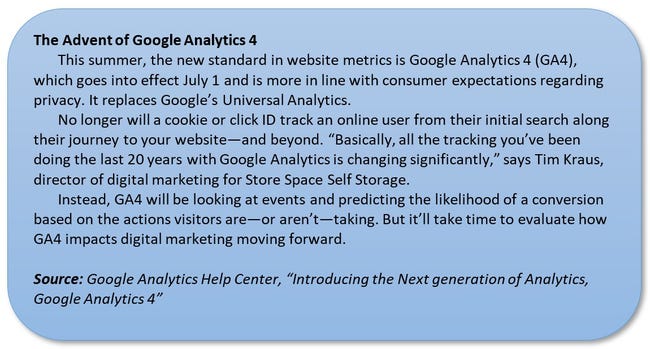The Wonders of Digital-Marketing Data: Where to Find It and How It Can Improve Your Self-Storage Business
If you aren’t tracking the performance of your self-storage operation’s digital marketing, you could be wasting money, but that isn’t all … You might be negatively impacting your business. Take a moment to read about the metrics you should watch, how to follow them and what to do with the information.
June 7, 2023

At its most basic, digital marketing is the process of using online tools to attract potential customers to your self-storage business. In many aspects, it has surpassed traditional (offline) marketing because it looks to reach prospects where and when they’re searching for products and services, like when they’re near your physical location. It even seeks to understand what they’re doing after they’ve interacted with your company online.
Tracking is the key to digital-marketing success because it allows you to identify gaps in your strategy, maximize results and ensure the best return on investment. It should tell you what is and isn’t working, which means knowing where to spend more or less money on marketing campaigns.
Tracking is about using the right metrics to gather data about your digital marketing, so you can make informed decisions on behalf of your self-storage operation. However, you only want data that’s reliable. Even then, it must be interpreted properly. Let’s look at good ways to track your efforts and what to do with the information.
The Metrics to Track
Your digital-marketing plan should specify your strategy for generating leads and reaching your target self-storage market, but it should also identify all metrics to be tracked. To begin, decide which online events represent the most value to your operation. For example, any action that results in a unit reservation or rental is generally considered a successful conversion; but there are many other numbers you might choose to follow such as:
Total clicks
Cost per click
Clicks per conversion
Cost per acquisition
Average customer length of stay
Average lifetime value of customer
Website visits
Website page views
Unique website visitors
Average pages viewed per visit
Average time spent per visit
Domestic vs. foreign traffic
Search engine vs. direct traffic
Number of followers, comments or likes on social media
The more metrics you track, the more granular you can get with your data, which allows for greater analysis. For example, see the accompanying table. This self-storage operator is gathering several key pieces of information. The primary variable is the number of clicks it takes to get a conversion (reservation or rental). In the second scenario, it takes twice as many, which significantly impacts net revenue per customer.

On the surface, a high number of clicks may seem like a good thing; but if you aren’t converting those clicks into paying customers, it could be a signal that there’s something wrong with or missing from your self-storage website. Perhaps there’s a poor user experience on the landing page, your rates are too high, the customer can’t find the information they need, etc. The important thing is that once an issue is identified, true discovery can begin.
How to Track
There are many platforms, apps and tools that can help you track your self-storage digital marketing. The best ones integrate as much information from as many sources as possible to provide a broader picture of performance. Here are a few to consider:
Website analytics. Understanding what visitors are doing on your website, such as how long they’re there, which pages they visit, and whether they convert is critical. Some website platforms, such as Squarespace, Wix and WordPress, have built-in analytics. However, Google Analytics is the industry standard for integrating data from multiple sources. It’s installed on a website by pasting code on the back end.
Ad platforms. Paid ad networks, such as Bing Ads and Google Ads, allow you to track various key performance indicators including clicks, click-through rate and conversions. Basically, they tell you what consumers are doing when they interact with your ads. This helps you gauge the effectiveness of your promotions.
Call tracking. This software allows you to determine the source of a phone call, down to the specific ad or web page. In most cases, you replace your business phone number with trackable, dynamic numbers in your marketing campaigns.
What to Do With the Info
All of your self-storage operation’s digital marketing—including paid ads, social media posts, tracked calls and organic results—are generating data. The next hurdle is understanding what to do with it.
As traffic starts to flow to your website, it’s important to establish a baseline. This’ll help you set a budget, create forecasting models, develop new strategies and refine marketing campaigns. As additional results become available, you can use them to chart short- and long-term progress against your baseline and adjust your approach. For example, you might change your targeting, update your ads and promotional offers, or tweak your ad spend. You might adapt your media mix to one channel or another.
It’s also important to use the data to identify gaps in other facets of your self-storage operation, not just marketing. Is there an issue with your customer service or pricing? Is there low demand for particular unit sizes? Are your tracked phone lines being answered in a timely manner? Your marketing data can help open those discussions with various team members and departments, so you can work together toward solutions.

Interpreting Your Data
A web-analytics service like Google Analytics is the most common method for determining the source of your online traffic, especially from your website. However, there are other tools that can facilitate these efforts. Each has its own dashboards and reports to deliver data about clicks, visits, time spent on web pages and so on. Many are helpful, but don’t overload on too many systems. Similarly, you don’t want to underutilize the platforms to which you have access.
Generally, any digital channel you use will provide some means of tracking customers to your website, usually by following pixels or snippets of code. However, an improperly integrated system can lead to inaccurate information, which can skew results and cause you to make poor decisions. Additionally, using too many third-party tracking tools on your website can slow its performance, which can adversely affect your conversion rate.
Often, the answer is to hire an analyst or specialized marketing agency to help interpret your data. If you take this path, you need to meet regularly and review the third party’s reporting to ensure your money is being well spent.
Remember, accruing data isn’t the final goal of tracking your digital marketing. What you’re ultimately after is the plan of action that emerges from whatever the data tells you. If you can’t properly interpret the information to create and implement a successful strategy, it won’t matter that you’re tracking the data or how much of it you collect.
Eric Mees is content manager for Store Space Self Storage. A graduate of Metropolitan State University of Denver, he joined the company in 2020 after more than two decades in various digital marketing and journalism positions. Based in Winter Garden, Florida, Store Space owns, operates and third-party manages more than 100 self-storage properties in 22 states. For more information, email [email protected].
About the Author(s)
You May Also Like





